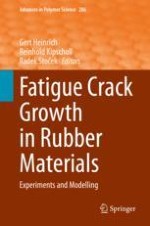The book summarizes recent international research and experimental developments regarding fatigue crack growth investigations of rubber materials. It shows the progress in fundamental as well as advanced research of fracture investigation of rubber material under fatigue loading conditions, especially from the experimental point of view. However, some chapters will describe the progress in numerical modeling and physical description of fracture mechanics and cavitation phenomena in rubbers.
Initiation and propagation of cracks in rubber materials are dominant phenomena which determine the lifetime of these soft rubber materials and, as a consequence, the lifetime of the corresponding final rubber parts in various fields of application. Recently, these phenomena became of great scientific interest due to the development of new experimental methods, concepts and models. Furthermore, crack phenomena have an extraordinary impact on rubber wear and abrasion of automotive tires; and understanding of crack initiation and growth in rubbers will help to support the growthing number of activities and worldwide efforts of reduction of tire wear losses and abrasion based emissions.
